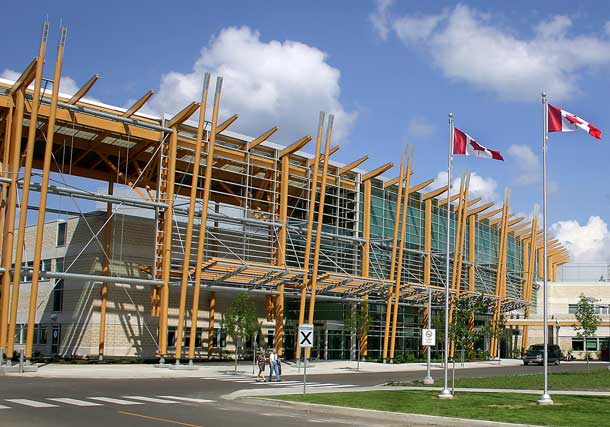THUNDER BAY – Ontario is increasing access to important health care services and reducing wait times for people in the North by investing in a comprehensive cardiovascular surgery facility at Thunder Bay Regional Health Sciences Centre.
“Today’s announcement of the funding for the capital component of the Thunder Bay Regional Health Sciences Centre’s Cardiovascular Surgery Project is exciting news for all of the citizens of Northwestern Ontario. This is another major step forward and builds upon the establishment of local angioplasty services by our government in 2009, and the recently announced vascular surgery program. The delivery of cardiac surgery in Thunder Bay will not only improve wait times, but will allow patients to stay close to their families and friends. There is also a major economic benefit that will result from having cardiovascular surgery available in Thunder Bay, including opportunities for expanding the region’s growing biomedical cluster of businesses,” says MPP Bill Mauro.
Mauro who has been a major advocate for this area of healthcare adds, “This is another major step forward and builds upon the establishment of local angioplasty services by our government in 2009, averaging 700 surgeries per year. Local vascular surgery, made available this year is expected to average 600 surgeries per year and now with the announcement of cardiac surgery expected by 2020, another 400 surgeries per year. This will bring the total to approximately 1700 patients per year receiving these services right here in Thunder Bay, allowing patients to stay close to their families and friends. This exciting announcement will also create 60-70 new jobs in addition to the jobs already in place for angioplasty and vascular surgery.”
Thunder Bay Superior MPP Michael Gravelle states, “I am very proud of our government’s commitment and support of this comprehensive cardiovascular surgery program to Thunder Bay Regional Health Science Centre. It’s a plan that makes sense in many different ways, including adding to our health care potential, reducing wait times, increasing our health care capacity and ensuring more patients stay in Thunder Bay to receive the care they need. This program is an excellent fit with our government’s commitment to putting patients first.”
“Thunder Bay Regional Health Sciences Centre is committed to meeting the specialized acute care needs of the Northwestern Ontario residents. Access to comprehensive cardiovascular surgical care, closer to home, is essential in our region where the prevalence and incidence of cardiovascular conditions are well above the provincial averages. This will improve the breadth of specialized clinical services, the care outcomes, and quality of life for hundreds of patients annually. We are very grateful to the Ministry of Health and Long-Term Care and to our partner, the University Health Network, for making this a reality,” comments Jean Bartkowiak, President and CEO, Thunder Bay Regional Health Sciences Centre.
“Thunder Bay Regional Health Sciences and University Health Network’s Peter Munk Cardiac Centre have made enormous progress on the development of one program on two sites. We are very pleased that this way of working together has been recognized by the Government of Ontario and Minister Hoskins, and that this investment in Thunder Bay’s facilities will help patients in Northwestern Ontario rapidly access the cardiac care they require closer to home,” shares Dr. Barry Rubin, Program Medical Director of the Peter Munk Cardiac Centre, University Health Network
Dr. Eric Hoskins, Minister of Health and Long-Term Care, was at the Thunder Bay Regional Health Sciences Centre Wednesday to announce new construction and renovations at the hospital to house the new program.
Once fully operational, the program will provide care closer to home for approximately 1,000 patients in Northwestern Ontario each year, meaning fewer trips to Toronto, Ottawa, London and Hamilton for the cardiovascular procedures they need.
This project involves new construction and renovation of more than 20,000 square feet at the hospital, and will include:
- An ambulatory care and pre-admission clinic expansion
- A new vascular laboratory
- 14 new cardiovascular inpatient beds
- 5 new stepdown beds for transitional care
- 1 new surgical suite, equipped with advanced imaging technology and a recovery area.
Ontario is increasing access to care, reducing wait times and improving the patient experience through its Patients First: Action Plan for Health Care and OHIP+: Children and Youth Pharmacare – protecting health care today and into the future.
Quick Facts
- Ontario is expanding the Northern Health Travel Grant Program by $10 million in 2017-18. The program helps people in northern Ontario cover their travel costs for services or procedures that are not available in their local communities.
- Ontario’s health care budget in 2017-18 is $53.8 billion — a 3.8 per cent increase from the previous year.
- The total planned investment in Ontario’s hospital infrastructure will be more than $20 billion over the next 10 years. About 34 hospital projects are now underway across the province.
- Ontario is making the largest investment in hospitals, schools, public transit, roads and bridges in the province’s history – more than $190 billion in public infrastructure over 13 years, starting in 2014–15. To learn more about what’s happening in your community, go to Ontario.ca/BuildON.



